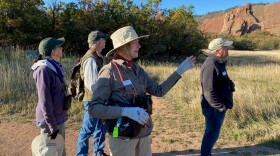-
It's National Pollinator Week. From bees to butterflies, hummingbirds to moths, these species play a crucial role in agriculture and healthy ecosystems.
-
The warming climate has led to some subtle changes in the size and wings of birds — some faster than others, according to new analysis from researchers at the University of Michigan.
-
Every spring, a mating osprey couple returns to the same nest in Grand Lake to lay their eggs and raise their fledglings. Osprey enthusiasts can follow along via livestream courtesy of the osprey cam.
-
As of March 7, Colorado has had 206 wild bird samples that have tested positive for the H5N1 virus, the most in the region.
-
With many bird populations in decline, two recent studies out of Colorado State University used weather radar to track the movements of swallows and martins to gain clues into how climate change and roost size affect their roosting habits.
-
Avian Flu is still hitting both commercial egg-producing operations and wild bird populations hard.A mushroom farm in Alamosa owes unpaid wages and faces allegations of unsafe working conditions after declaring bankruptcy and closing.
-
The National Audubon Society kicked off its annual bird count Wednesday — a program that helps experts understand how birds respond to climate change.
-
Colorado Sun reporter Michael Booth joins us to talk about the worst avian flu outbreak the state has ever seen and a Metropolitan State University of Denver biology professor who's doing "hands-on" West Nile Virus research with mosquitoes.
-
Two different populations of a prairie bird that lives in parts of the Mountain West were listed under the Endangered Species Act by the U.S. Fish and Wildlife Service.
-
Many birds are in trouble nationwide. A 2019 study published by Cornell found that bird populations have declined 30% since 1970. That's nearly three billion birds.

Play Live Radio
Next Up:
0:00
0:00
Available On Air Stations









